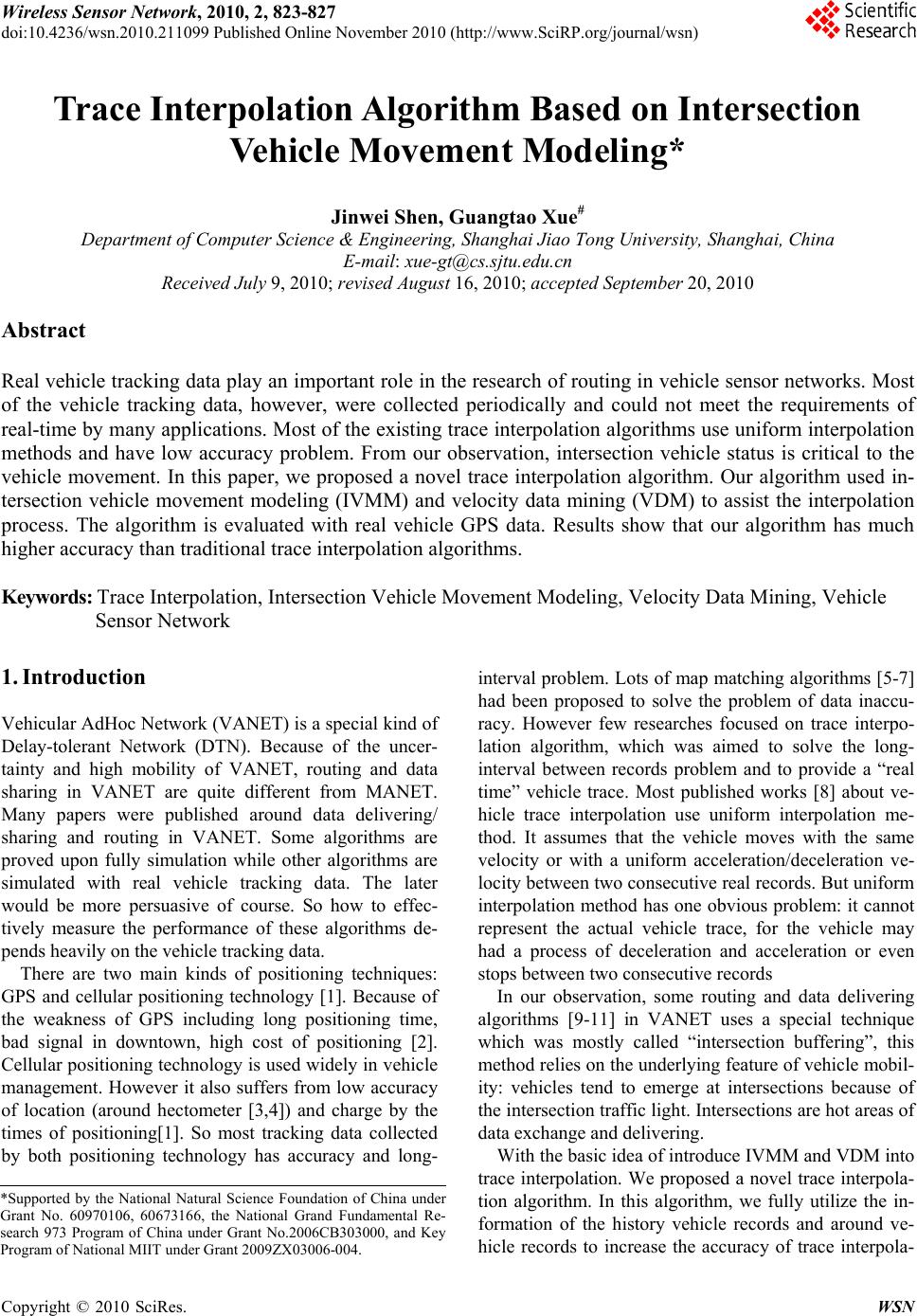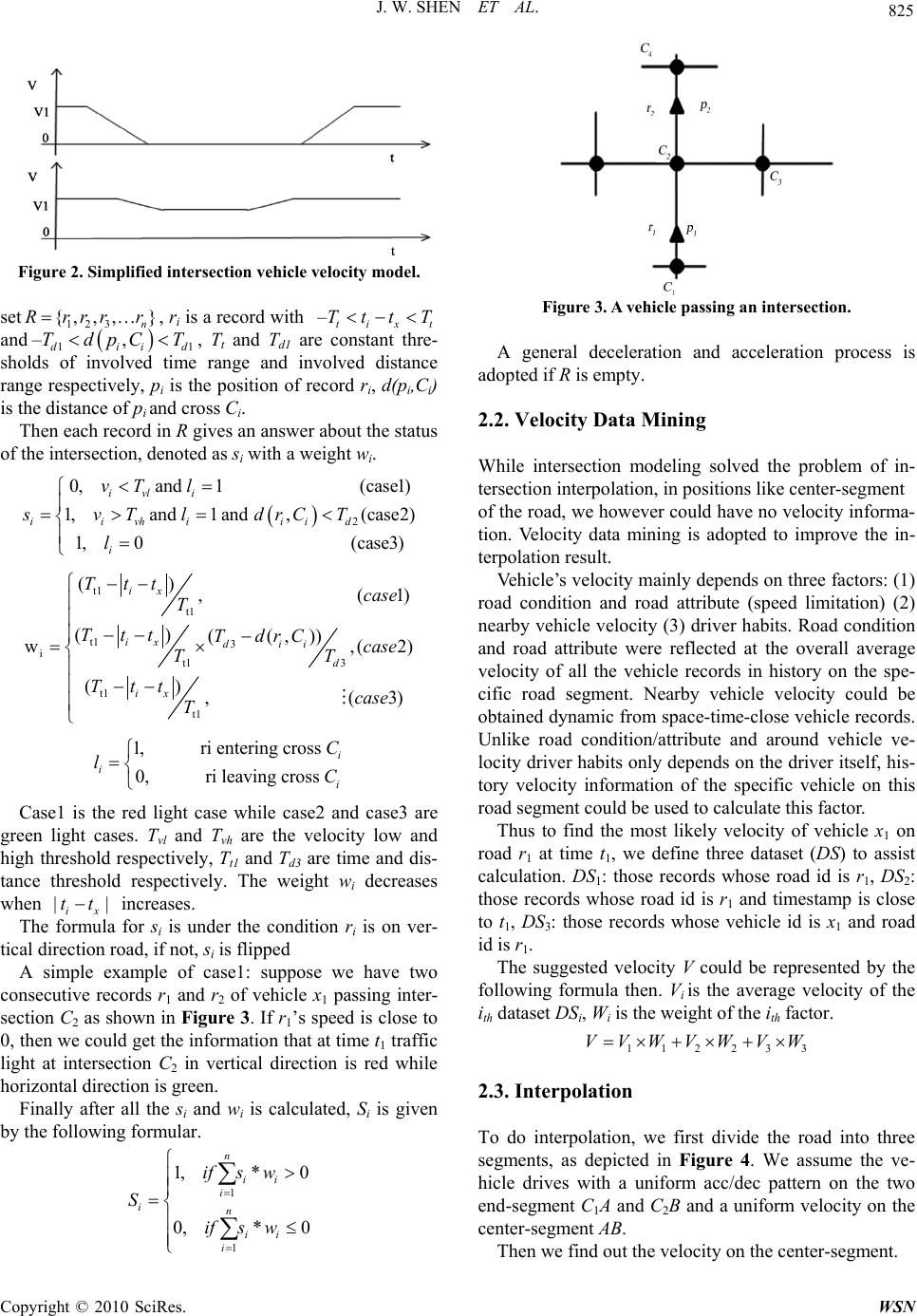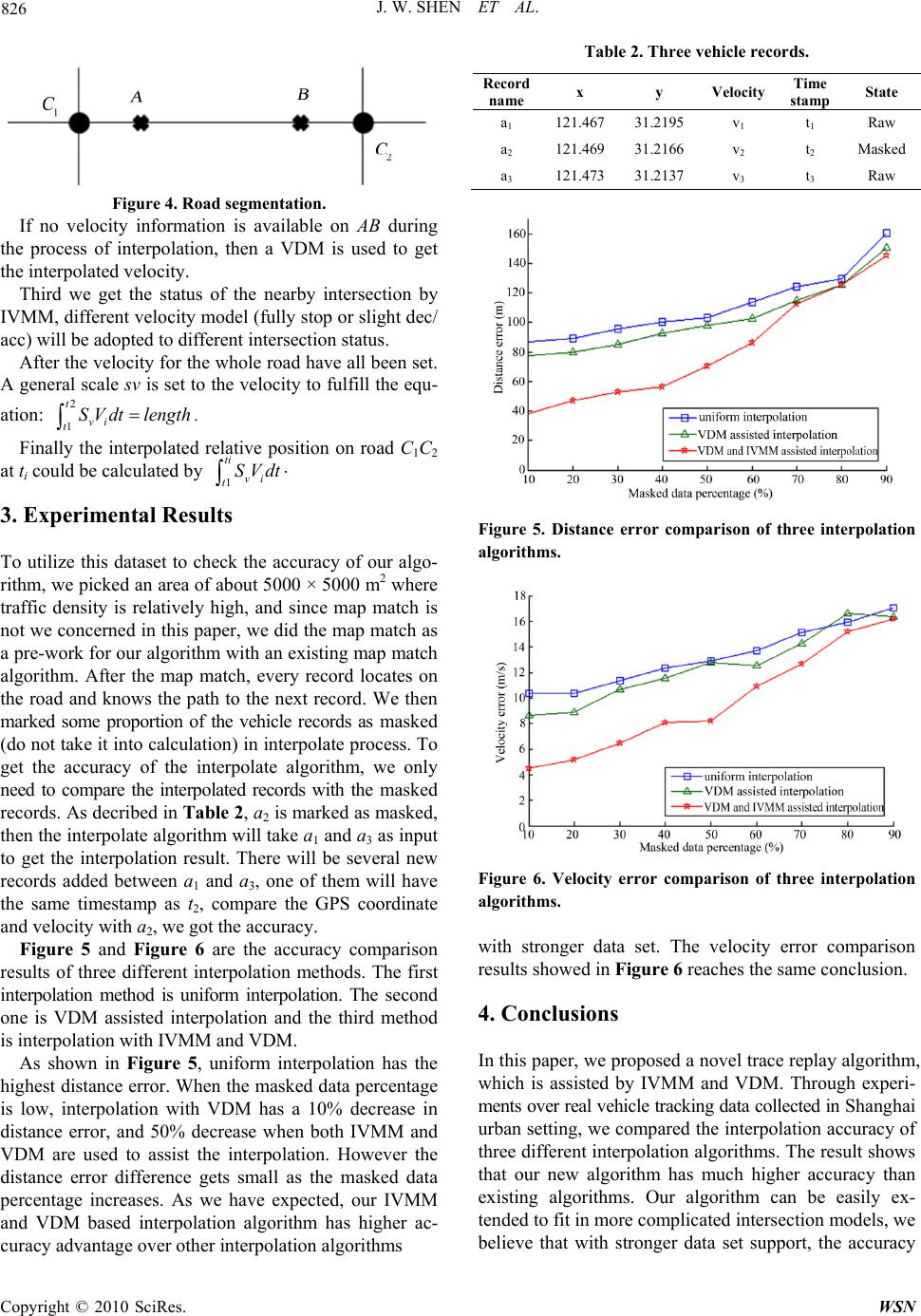Paper Menu >>
Journal Menu >>
 Wireless Sensor Network, 2010, 2, 823-827 doi:10.4236/wsn.2010.211099 Published Online November 2010 (http://www.SciRP.org/journal/wsn) Copyright © 2010 SciRes. WSN Trace Interpolation Algorithm Based on Intersection Vehicle Movement Modeling* Jinwei Shen, Guangtao Xue# Department of Computer Science & Engineering, Shanghai Jiao Tong University, Shanghai, China E-mail: xue-gt@cs.sjtu.edu.cn Received July 9, 2010; revised August 16, 2010; accepted September 20, 2010 Abstract Real vehicle tracking data play an important role in the research of routing in vehicle sensor networks. Most of the vehicle tracking data, however, were collected periodically and could not meet the requirements of real-time by many applications. Most of the existing trace interpolation algorithms use uniform interpolation methods and have low accuracy problem. From our observation, intersection vehicle status is critical to the vehicle movement. In this paper, we proposed a novel trace interpolation algorithm. Our algorithm used in- tersection vehicle movement modeling (IVMM) and velocity data mining (VDM) to assist the interpolation process. The algorithm is evaluated with real vehicle GPS data. Results show that our algorithm has much higher accuracy than traditional trace interpolation algorithms. Keywords: Trace Interpolation, Intersection Vehicle Movement Modeling, Velocity Data Mining, Vehicle Sensor Network 1. Introduction Vehicular AdHoc Network (VANET) is a special kind of Delay-tolerant Network (DTN). Because of the uncer- tainty and high mobility of VANET, routing and data sharing in VANET are quite different from MANET. Many papers were published around data delivering/ sharing and routing in VANET. Some algorithms are proved upon fully simulation while other algorithms are simulated with real vehicle tracking data. The later would be more persuasive of course. So how to effec- tively measure the performance of these algorithms de- pends heavily on the vehicle tracking data. There are two main kinds of positioning techniques: GPS and cellular positioning technology [1]. Because of the weakness of GPS including long positioning time, bad signal in downtown, high cost of positioning [2]. Cellular positioning technolog y is used widely in vehicle management. However it also suffers from low accuracy of location (around hectometer [3,4]) and charge by the times of positioning[1]. So most tracking data collected by both positioning technology has accuracy and long- interval problem. Lots of map matching algorithms [5-7] had been proposed to solve the problem of data inaccu- racy. However few researches focused on trace interpo- lation algorithm, which was aimed to solve the long- interval between records problem and to provide a “real time” vehicle trace. Most published works [8] about ve- hicle trace interpolation use uniform interpolation me- thod. It assumes that the vehicle moves with the same velocity or with a uniform acceleration/deceleration ve- locity between two consecutive real reco rds. But uniform interpolation method has one obvious problem: it cannot represent the actual vehicle trace, for the vehicle may had a process of deceleration and acceleration or even stops between two consecutive records In our observation, some routing and data delivering algorithms [9-11] in VANET uses a special technique which was mostly called “intersection buffering”, this method relies on the underlying feature of vehicle mobil- ity: vehicles tend to emerge at intersections because of the intersection traffic light. Intersections are hot areas of data exchange and delivering. With the basic idea of introduce IVMM and VDM into trace interpolation. We proposed a novel trace interpola- tion algorithm. In this algorithm, we fully utilize the in- formation of the history vehicle records and around ve- hicle records to increase the accuracy of trace interpola- *Supported by the National Natural Science Foundation of China unde r Grant No. 60970106, 60673166, the National Grand Fundamental Re- search 973 Program of China under Grant No.2006CB303000, and Key Program o f Na t i o nal MIIT under Grant 2009ZX03 0 0 6 -004.  J. W. SHEN ET AL. Copyright © 2010 SciRes. WSN 824 tion algorithm. The rest of this paper is organized as follows. In Sec- tion 2, we introduce the IVMM and VDM technique and our trace interpolation algorithm. Section 3 provides the experimental results based on real tracking data. Section 4 includes the conclusion of this paper. 2. Trace Interpolation Algorithm This paper’s work is based on data collected by 4000 taxis in Shanghai urban setting during several months in 2006, and we have the digital map information of the whole area. Every record in the dataset includes the ve- hicle’s id, vehicle’s GPS position, velocity information, vehicle direction and timestamp. The interval of the records varies from seconds to minutes. Table 1 presents us two consecutive vehicle tracking records with some fields omitted. Since map matching is not what we concerned in this paper, we assume that record r1 was matched to road position p1 on road C1C2 and record r2 was matched to position p2 on road C3C4, and the vehicle drives from p1 to p2 through cross C2 and C3 as depicted in Figure 1. Suppose t1 and t2 has a gap of 1 min, if the required timestamp granularity by application is 1 sec, then trace interpolation is used to get the records or to find out where the vehicle is at each second between t1 and t2. If we know how fast the vehicle drives at each position along the matched roads, it will be easy for us to know where the vehicle is at timestamp tx. So trace interpola- tion problem could be mapped to velocity finding prob- lem. In uniform interpolation algorithm, uniform velocity distribution was adopted, which means during the time t1 Table.1 Two vehicle records. Figure 1. Map matched vehicle records. to t2 the velocity of the vehicle is calculated by 1223322 1 ()/()VpCCCCptt . This could hardly match the real case. Following introduces our trace replay algorithm: 2.1. Intersection Vehicle Movement Modeling Traditional interpolate algorithm assumes the vehicle move through the intersections at its normal speed with- out deceleration and stop. In reality, vehicles rarely keep the normal speed at the intersection because of traffic control signals [11]. Most vehicles experience decelera- tion and acceleration and often wait in line with full stop [12]. There are many different intersection structures in re- ality, such as signalized, isolated, roundabout, etc. Our intersection velocity model only studies the vehicle move- ment at the signalized intersection with two crossing paths. However different intersections would still have different traffic light models, and it is hard to precisely build different intersection models to different intersec- tions for we don’t have the traffic light information for each intersection. What’s more, a precise intersection model requires a relatively high volume of traffic density. We did some analysis based on the dataset and found there’s an average of 10 vehicle records near one inter- section per 2 min. With this observation, we compro- mised to build a simplified intersection model for all the signalized intersections. In this model, we had a simpli- fied traffic light model: (1) turn to right is always per- mitted (2) one of the two directions is fully permitted to go any direction at a time, and we assume the queue of vehicles would not surpass a specified length, which means the vehicle would not stop at a po sition that is far away from an intersection. Since most vehicles experience deceleration and acce- leration and sometimes wait in line with full stop, in our simplified model, we divide the intersection vehicle ve- locity model into two categories. As shown in Figure 2. The first one has a full stop while the second one ju st has a slight deceleration and acceleration. When a vehicle’s two consecutive records matched on two different roads, the interpolated trace between them would get through intersection. Our task is to find out th e intersection status of Ci at any time tx. Thus we will be able to distinguish if a vehicle stops at the intersection Ci at time tx and how long it stops if it did stops. We utilize a voting mechanism to decide the status 1, 0, i verticaldirection green Sverticaldirection red of an intersection Ci at time tx. First we find the involved (time-space close) record Record name x y Velocity Timestamp r1 121.467 31.2195 v1 t 1 r2 121.469 31.2166 v2 t 2  J. W. SHEN ET AL. Copyright © 2010 SciRes. WSN 825 Figure 2. Simplified intersection vehicle velocity model. set 123 {,, ,} n Rrrr r, ri is a record with –tix t TttT and 11 –, diid TdpCT , Tt and Td1 are constant thre- sholds of involved time range and involved distance range respectively, pi is the position of record ri, d(pi,Ci) is the distance of pi and cross Ci. Then ea ch recor d in R give s an an sw er ab out th e s tatu s of the intersection, denoted as si with a weight wi. 2 0,and 1(case1) 1,and1and ,(case2) 1,0(case3) ivl i iivhi iid i vT l svTl drCT l t1 t1 t1 3 it1 3 t1 t1 () ,(1) () ((,)) w,(2) () ,(3) ix ix dii d ix Tttcase T TttTdrCcase TT Ttt case T 1,ri entering cross 0,ri leaving cross i ii C lC Case1 is the red light case while case2 and case3 are green light cases. Tvl and Tvh are the velocity low and high threshold respectively, Tt1 and Td3 are time and dis- tance threshold respectively. The weight wi decreases when || ix tt increases. The formula for si is under the condition ri is on ver- tical direction road, if not, si is flipped A simple example of case1: suppose we have two consecutive records r1 and r2 of vehicle x1 passing inter- section C2 as shown in Figure 3. If r1’s speed is close to 0, then we could get the info rmation that at ti me t1 traffic light at intersection C2 in vertical direction is red while horizontal direction is green. Finally after all the si and wi is calculated, Si is given by the following formular. 1 1 1,* 0 0,* 0 n ii i in ii i ifs w S ifs w Figure 3. A vehicle passing an intersection. A general deceleration and acceleration process is adopted if R is empty. 2.2. Velocity Data Mining While intersection modeling solved the problem of in- tersection interpolation, in positions like center-segment of the road, we however could have no velocity informa- tion. Velocity data mining is adopted to improve the in- terpolation result. Vehicle’s velocity mainly depends on three facto rs: (1) road condition and road attribute (speed limitation) (2) nearby vehicle velocity (3) driver habits. Road condition and road attribute were reflected at the overall average velocity of all the vehicle records in history on the spe- cific road segment. Nearby vehicle velocity could be obtained dynamic from space-time-close vehicle records. Unlike road condition/attribute and around vehicle ve- locity driver habits only de pends on the driver itself, his- tory velocity information of the specific vehicle on this road segment could be used to calculate this factor. Thus to find the most likely velocity of vehicle x1 on road r1 at time t1, we define three dataset (DS) to assist calculation. DS1: those records whose road id is r1, DS2: those records whose road id is r1 and timestamp is close to t1, DS3: those records whose vehicle id is x1 and road id is r1. The suggested velocity V could be represented by the following formula then. Vi is the average velocity of the ith dataset DSi, Wi is the weight of the ith factor. 112 233 VVWVWVW 2.3. Interpolation To do interpolation, we first divide the road into three segments, as depicted in Figure 4. We assume the ve- hicle drives with a uniform acc/dec pattern on the two end-segment C1A and C2B and a uniform velocity on the center-segment AB. Then we find out the velocity on the center-segment.  J. W. SHEN ET AL. Copyright © 2010 SciRes. WSN 826 Figure 4. Road segmentation. If no velocity information is available on AB during the process of interpolation, then a VDM is used to get the interpolated velocity. Third we get the status of the nearby intersection by IVMM, different velocity model (fully stop or slight dec/ acc) will be adopted to different intersection status. After the velocity for the whole road have all been set. A general scale sv is set to the velocity to fulfill th e equ- ation: 2 1 t vi tSV dtlength . Finally the interpolated relative position on road C1C2 at ti could be calculated by 1 ti vi tSVdt 3. Experimental Results To utilize this dataset to check the accuracy of our algo- rithm, we picked an area of abou t 5000 × 5000 m2 where traffic density is relatively high, and since map match is not we concerned in this paper, we did the map match as a pre-work for our algorithm with an existing map match algorithm. After the map match, every record locates on the road and knows the path to the next record. We then marked some proportion of the vehicle records as masked (do not take it into calculatio n) in interpolate process. To get the accuracy of the interpolate algorithm, we only need to compare the interpolated records with the masked records. As decribed in Table 2, a2 is marked as masked, then the interpolate algo rithm will take a1 and a3 as input to get the interpolation result. There will be several new records added between a1 and a3, one of them will have the same timestamp as t2, compare the GPS coordinate and velocity with a2, we got the accuracy. Figure 5 and Figure 6 are the accuracy comparison results of three different interpolation methods. The first interpolation method is uniform interpolation. The second one is VDM assisted interpolation and the third method is interpolation with IVMM and VDM. As shown in Figure 5, uniform interpolation has the highest distance error. When the masked data percentage is low, interpolation with VDM has a 10% decrease in distance error, and 50% decrease when both IVMM and VDM are used to assist the interpolation. However the distance error difference gets small as the masked data percentage increases. As we have expected, our IVMM and VDM based interpolation algorithm has higher ac- curacy advantage over other interpolation algorithms Table 2. Three vehicle records. Figure 5. Distance error comparison of three interpolation algorithms. Figure 6. Velocity error comparison of three interpolation algorithms. with stronger data set. The velocity error comparison results showed in Figure 6 reaches the same conclusion. 4. Conclusions In this paper, we proposed a novel trace replay algorithm, which is assisted by IVMM and VDM. Through experi- ments over real vehicle tracking data collected in Sha ng ha i urban setting, we compared the interpolation accuracy of three different interpolation algorithms. The result shows that our new algorithm has much higher accuracy than existing algorithms. Our algorithm can be easily ex- tended to fit in more complicated intersection models, we believe that with stronger data set support, the accuracy Record name x y Velocity Time stamp State a1 121.467 31.2195 v1 t 1 Raw a2 121.469 31.2166 v2 t 2 Masked a3 121.473 31.2137 v3 t 3 Raw  J. W. SHEN ET AL. Copyright © 2010 SciRes. WSN 827 of our algorithm can be even higher. 5. References [1] X. W. Chen, F. Z. Zhang, M. Sun and Y. H. Luo, “Sys- tem Architecture of LBS Based on Spatial Information Integration,” IEEE International conference on Geos- cience and Remote Sensing Symposium, 2004. IGARSS '04. Proceedings, Anchorage, Alaska, Vol. 4, September 2004, pp. 2409-2411. [2] Y. Q. Huang and X. M. Gu, “The Combination of GPS and GSM Mobile Location Technology,” Journal of Jiamusi University, Sicence, Vol. 23, October 2005, pp. 530-533. [3] L. Perusco and K. Michael, “Humancentric Applications of Precise Location Based Services,” IEEE International Conference on e-Business Engineering, Beijing, 18-21 October 2005, pp. 409-418. [4] M. Wallbaum and S. Diepolder, “Benchmarking Wireless Location Systems,” The Second International Workshop on Mobile Commerce and Services, IEEE, Germany, July 2005, pp. 42-51. [5] D. Bernstein and A. Kornhauser, “An Introduction to Map Matching for Personal Navigation Assistants,” Tech- nical report, New Jersey TIDE Center Technical Report, 1996. [6] M. Quddus, W. Ochieng, L. Zhao and R. Noland, “A General Map Matching Algorithm for Transport Tele- matics Applications,” GPS Solutions Journal, Vol. 7, No. 3, 2003, pp. 157-167. [7] H. Yin and O. Wolfson, “A Weight-Based Map Matching Method in Moving Objects Databases,” In Proceedings of 16th SSDBM conference, Santorini Island, Greece, 2004, pp. 437-438. [8] H. H. Gao, K. B. Jia, X. H. Bao and J. He, “Research and Implementation of Road Match and Trace Replay Algo- rithm,” MultiMedia and Information Technology, Three Gorges, 30-31 December 2008, pp. 74-77. [9] J. Zhao and G. Cao, “VADD: Vehicle-Assisted Data Delivery in Vehicular Ad Hoc Networks,” Proceedings of IEEE INFOCOM’06, Barcelona, April 2006, pp. 1-12. [10] M. Jerbi, S. M. Senouci, R. Meraihi and Y. Ghamri- Doudane, “An Improved Vehicular Ad Hoc Routing Pro- tocol for City Environments,” IEEE International Confe- rence on Communications, Glasgow, 24-28 June 2007, pp. 3972-3979. [11] J. Zhao, Y. Zhang and G. Cao, “Data Pouring and Buf- fering on the Road: A New Data Disseminat ion Paradigm for Vehicular Ad Hoc Networks,” IEEE Transactions on Vehicular Technology, Vol. 56, No. 6, November 2007, pp. 3266-3277. [12] F. Dion, H. Rakha and Y. Kang, “Comparison of Delay Estimates at Undersaturated and Over-Saturated Pre- Timed Signalized Intersections,” Transportation Research, Part B: Methodological, Vol. 38, No. 2, Feburary 2004, pp. 99-122. |

